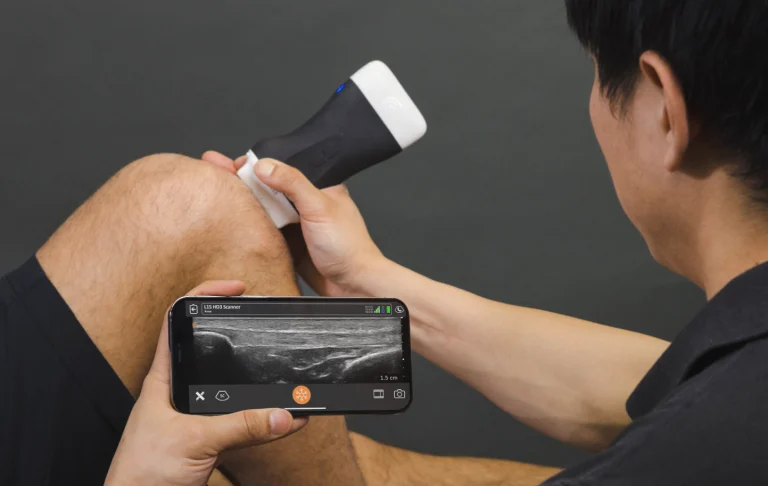Accurate diagnosis is essential for anyone striving to stay active, recover quickly, and maintain a healthy lifestyle. Modern medical technology has made significant advances in this area, and one of the most noteworthy developments is Musculoskeletal Ultrasound Imaging. This advanced tool is transforming the way clinicians diagnose injuries and design treatment plans. From its cutting-edge technology to its cost-effectiveness and safety, Musculoskeletal Ultrasound Imaging is rapidly becoming the first choice for diagnosing muscle, tendon, ligament, and joint injuries.
What is Musculoskeletal Ultrasound Imaging?
Musculoskeletal Ultrasound Imaging is an innovative diagnostic technique that uses safe sound wave technology to produce real-time images of the body’s soft tissues. Unlike traditional X-rays or MRIs, which often require a waiting period for results, this method allows clinicians to view detailed images immediately. The clarity and immediacy of Musculoskeletal Ultrasound Imaging make it an invaluable tool in assessing injuries such as rotator cuff tendinitis, Achilles tendinitis, and plantar fasciitis.
By using sound waves instead of radiation, Musculoskeletal Ultrasound Imaging offers a non-invasive and patient-friendly approach to diagnosis. This minimizes patient discomfort and reduces the risks associated with radiation exposure. As a result, it has become an increasingly popular choice among physical therapists and medical professionals focused on sports medicine and orthopedics.
Benefits of Musculoskeletal Ultrasound Imaging
One of the standout qualities of Musculoskeletal Ultrasound Imaging is its comprehensive range of benefits. Below are some of the key advantages that have contributed to its growing use in clinical practice:
- Non-Invasive and Safe: The absence of radiation makes this imaging method safe for repeated use, a critical factor for monitoring recovery or conducting follow-up examinations.
- Cost-Effective: Compared to MRIs and X-rays, Musculoskeletal Ultrasound Imaging is more budget-friendly while still providing high-quality images. This affordability makes it accessible to a broader range of patients.
- Real-Time Diagnosis: Immediate visualization of injuries allows physical therapists to quickly adjust treatment plans, reducing downtime and leading to more effective rehabilitation.
- Precision in Detection: With the ability to capture dynamic movements of muscles, tendons, and ligaments, Musculoskeletal Ultrasound Imaging can identify subtle abnormalities that might be missed with static imaging techniques.
These benefits are particularly valuable for individuals with active lifestyles, including runners, gym enthusiasts, and CrossFit athletes, who depend on timely and accurate diagnoses to maintain peak performance and prevent further injury.
Common Injuries Diagnosed with Musculoskeletal Ultrasound Imaging
Musculoskeletal Ultrasound Imaging excels in diagnosing a wide array of injuries. Here are some of the most common conditions assessed with this innovative technique:
- Rotator Cuff Tendinitis: Often seen in athletes who perform repetitive overhead motions, rotator cuff tendinitis can cause significant shoulder pain and reduced mobility. Real-time imaging assists in pinpointing the exact location and severity of the inflammation.
- Achilles Tendinitis: This condition, frequently affecting runners and jumping athletes, results in pain and stiffness in the Achilles tendon. Ultrasound imaging is particularly useful in detecting microtears and degeneration early in the process.
- Plantar Fasciitis: Individuals suffering from heel pain due to plantar fasciitis benefit greatly from early diagnosis with Musculoskeletal Ultrasound Imaging. The technology allows clinicians to observe the state of the plantar fascia, facilitating prompt and effective treatment.
- Ligament Injuries: Injuries to the medial collateral ligament (MCL) or lateral collateral ligament (LCL), among others, can be accurately assessed using ultrasound. This is critical in developing rehabilitation programs that target the specific injured area.
- Other Conditions: From patellar tendinitis to IT band syndrome, Musculoskeletal Ultrasound Imaging provides clear, detailed images that support correct diagnosis and tailored treatment strategies.
These precise diagnostic capabilities not only enhance treatment outcomes but also empower patients with a better understanding of their condition and the steps required for recovery.
Musculoskeletal Ultrasound Imaging vs. Traditional Imaging Methods
Traditional imaging techniques such as MRIs and X-rays have been the standard in medical diagnostics for decades. However, Musculoskeletal Ultrasound Imaging offers several compelling advantages over these conventional methods:
- Accessibility and Speed: Unlike MRIs, which often require scheduling delays and lengthy scanning sessions, ultrasound imaging can be performed quickly, often right in the clinic. This is particularly advantageous for active individuals who need rapid diagnosis and treatment.
- Cost Considerations: MRIs and X-rays can be expensive and may not be covered fully by insurance for every condition. Musculoskeletal Ultrasound Imaging provides a more cost-effective solution without compromising on diagnostic quality.
- Dynamic Examination: Traditional methods capture static images, which may not fully depict the functional issues of soft tissues during movement. Ultrasound, on the other hand, offers real-time imaging that can observe tissues in motion, providing deeper insights into the mechanics of injuries.
- Patient Comfort: The non-invasive and radiation-free nature of ultrasound imaging increases patient comfort and safety. This is particularly important for individuals undergoing multiple evaluations during their recovery process.
By comparing these factors, it becomes clear that Musculoskeletal Ultrasound Imaging is not just an alternative to traditional methods but, in many cases, a superior choice for specific diagnostic needs.
Who Benefits from Musculoskeletal Ultrasound Imaging?
The dynamic nature of Musculoskeletal Ultrasound Imaging means it caters to a wide range of individuals, but certain groups particularly benefit from this technology:
- Active Individuals and Athletes: Whether you’re an avid runner, a gym-goer, or a CrossFit enthusiast, timely and accurate diagnosis is key to optimal performance and speedy recovery. This imaging technique’s ability to assess injuries in real time ensures that athletes receive tailored treatment plans that address their specific needs.
- Patients in Rehabilitation: For those recovering from surgeries or long-term injuries, Musculoskeletal Ultrasound Imaging can monitor progress and adjust rehabilitation strategies as needed. This tailored care leads to better outcomes and reduces the risk of re-injury.
- Elderly Patients: Older adults, who may be more susceptible to injuries due to age-related degeneration of joints and soft tissues, can also benefit from the non-invasive and low-risk nature of ultrasound imaging. This method provides detailed images without subjecting patients to the risks associated with radiation.
- Pediatric Patients: In children, where minimizing exposure to radiation is crucial, ultrasound imaging provides a safe alternative for diagnosing musculoskeletal injuries.
Musculoskeletal Ultrasound Imaging facilitates personalized treatment by offering detailed insights into the precise nature of an injury. This allows healthcare providers to construct rehabilitation programs that focus on individual needs, thereby improving recovery times and outcomes.
The Local Impact: Musculoskeletal Ultrasound Imaging in Fishers, IN
Fishers, IN, is emerging as a hub for advanced imaging technology, particularly for musculoskeletal injuries. The availability of Musculoskeletal Ultrasound Imaging in this locale offers several local benefits:
- Expert Care in Your Community: With skilled professionals utilizing state-of-the-art ultrasound imaging, patients in Fishers receive world-class diagnostics and tailored treatment plans without needing to travel long distances.
- Enhanced Local Healthcare: Bringing advanced imaging techniques like Musculoskeletal Ultrasound Imaging to the local community ensures that sports injuries and musculoskeletal issues are promptly and accurately diagnosed, leading to better overall healthcare outcomes.
- Community Wellbeing: Active residents and athletes in Fishers benefit from immediate care and expert diagnosis, helping them return to their routines quickly and safely. Local clinics and physical therapy centers are increasingly integrating this technology into their practices, further solidifying Fishers’ reputation as a community that values health and wellness.
What to Expect During a Musculoskeletal Ultrasound Imaging Session
Understanding what happens during a Musculoskeletal Ultrasound Imaging session can help alleviate any concerns and set the stage for a smooth diagnostic process. Here’s what you can typically expect:
- Preparation: There is minimal preparation required. You may be advised to wear comfortable clothing and remove any accessories that could interfere with the imaging process.
- During the Session: The procedure begins with the application of a clear, water-based gel to the area of interest. This gel helps transmit the sound waves effectively. A handheld transducer is then moved over the skin, sending sound waves into the tissues and capturing the returning echoes to create an image on the screen. This process is painless and lasts only a few minutes.
- Real-Time Imaging: The benefit of real-time imaging is evident as the clinician can immediately observe the condition of the muscles, tendons, or ligaments. This allows for on-the-spot adjustments to the examination if necessary.
- Aftercare: There is no downtime following the procedure. The gel is wiped off, and you can resume normal activities immediately. In some cases, your doctor might suggest follow-up sessions based on the severity of the injury and your treatment plan.
This straightforward process underscores why Musculoskeletal Ultrasound Imaging is favored by both patients and clinicians—it’s efficient, informative, and minimally disruptive to your day.
Expert Insights and Success Stories
Healthcare professionals who specialize in musculoskeletal injuries consistently praise Musculoskeletal Ultrasound Imaging for its precision and versatility. Here are some insights and case examples that illustrate its impact:
- Expert Opinions: Physical therapists and radiologists emphasize that the detailed imaging provided by this technique is essential for developing targeted rehabilitation protocols. By identifying the exact location and extent of an injury, clinicians can tailor treatments to the individual, thereby reducing recovery times.
- Case Studies: Consider the case of an athlete who suffered from chronic Achilles tendinitis. Traditional imaging methods provided limited insights, but using Musculoskeletal Ultrasound Imaging revealed microtears and degenerative changes within the tendon. This critical information enabled the development of a custom rehabilitation plan that not only alleviated pain but also restored full functionality, allowing the athlete to return to competitive training faster.
- Patient Testimonials: Many patients have shared their positive experiences with this non-invasive imaging method. They report not only quicker diagnoses but also more accurate treatment outcomes, as the real-time images help pinpoint specific issues that need to be addressed.
These insights and success stories further highlight the reliability and effectiveness of Musculoskeletal Ultrasound Imaging in managing and treating a wide range of musculoskeletal injuries.
Frequently Asked Questions About Musculoskeletal Ultrasound Imaging
To address some common questions about this imaging technique, here are answers to frequently asked questions:
- Is Musculoskeletal Ultrasound Imaging safe?
Absolutely. This imaging method uses sound waves rather than radiation, making it a safe option for repeated use, especially important for monitoring progress during rehabilitation. - How long does the procedure take?
The entire imaging session typically lasts only a few minutes, although the exact time can vary based on the area being examined and the complexity of the injury. - Does the procedure cause any pain?
No, the procedure is non-invasive and painless. The application of the gel and the movement of the transducer usually cause minimal to no discomfort. - What conditions can be diagnosed with this technique?
Musculoskeletal Ultrasound Imaging is capable of diagnosing a wide range of conditions including rotator cuff tendinitis, Achilles tendinitis, plantar fasciitis, ligament injuries, and more. - Can I resume my normal activities after the session?
Yes, there is typically no downtime. Patients can resume normal activities immediately after the procedure.
These FAQs help build trust and provide clarity, ensuring that patients are well-informed and comfortable with the diagnostic process.
Takeaway
Musculoskeletal Ultrasound Imaging represents a significant leap forward in the field of injury diagnosis and treatment. With its non-invasive nature, cost-effectiveness, and immediate results, it is an ideal diagnostic tool for athletes, active individuals, and patients of all ages. Whether you’re dealing with a persistent shoulder injury, chronic heel pain, or any other musculoskeletal condition, this advanced imaging technique provides the detailed insights necessary for crafting a personalized and effective treatment plan.
For residents of Fishers, IN, accessing expert care with the latest technology has never been easier. The integration of Musculoskeletal Ultrasound Imaging into local clinics ensures that you benefit from rapid, accurate diagnoses and the tailored treatments that help you return to your favorite activities with confidence and strength.
By choosing Musculoskeletal Ultrasound Imaging, you are opting for a safe, effective, and modern approach to injury diagnosis. As healthcare continues to evolve, so does the commitment to improving patient outcomes. If you or someone you know is experiencing musculoskeletal pain or injury, consider discussing this advanced diagnostic option with your healthcare provider. Embrace the future of injury diagnosis and embark on a path to faster, more effective recovery.






